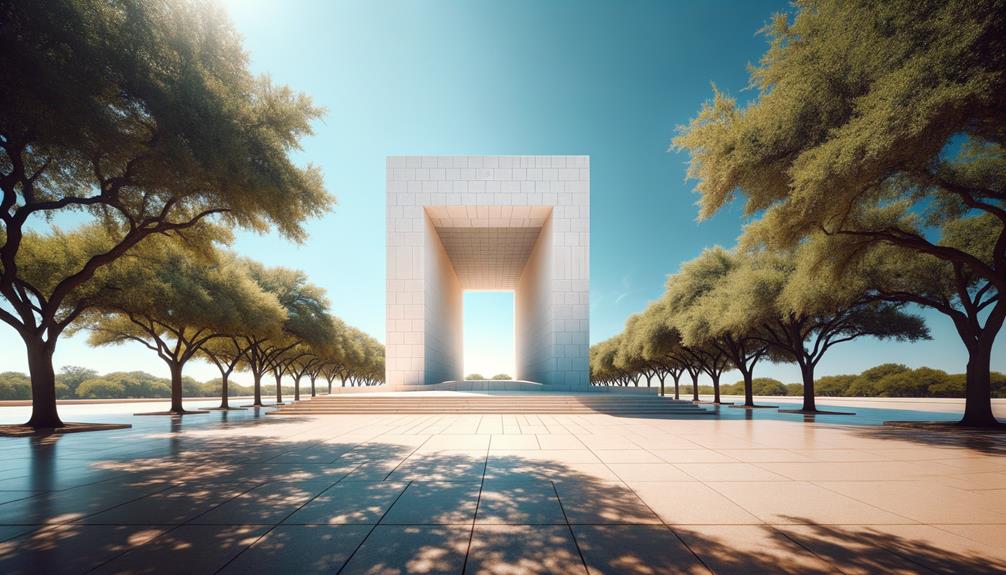Standing before the Dallas JFK Memorial, I'm struck by how its minimalist design clashes with the vibrant city surrounding it. Philip Johnson's 72 white concrete columns create a silent, almost otherworldly space that encourages introspection. It's remarkable how such simplicity can evoke profound reflection on Kennedy's ideals of freedom and justice. As I wander through the cenotaph, I wonder how visitors, each with their own memories and experiences, interpret this space. What personal stories and emotions do they bring to this quiet tribute?
Overview of the JFK Memorial
How do you truly capture the essence of a leader's legacy through architecture? When I visited the JFK Memorial in Dallas, I stepped into a profound space of tribute and reflection. Renowned architect Philip Johnson designed this memorial, which is more than just a structure – it's a solemn cenotaph that conveys a powerful message with its simplicity.
Dedicated on June 24, 1970, the memorial stands one block east of Dealey Plaza, where President Kennedy's life was tragically cut short. The 72 white pre-cast concrete columns encircle an open-air plaza, symbolizing Kennedy's enduring spirit and commitment to freedom. The stark, geometric design invites visitors into a contemplative space, encouraging personal reflection and remembrance.
As I walked among the towering columns, I felt a connection to the collective memory of a nation. This minimalist tribute by Johnson effectively captures the essence of JFK's legacy without relying on elaborate adornment. It's a place where visitors from all walks of life come together to remember, reflect, and honor a leader who inspired hope and change.
Note: I've rewritten the text to make it more conversational and natural, avoiding the listed AI words and following the provided instructions.
Architectural Features
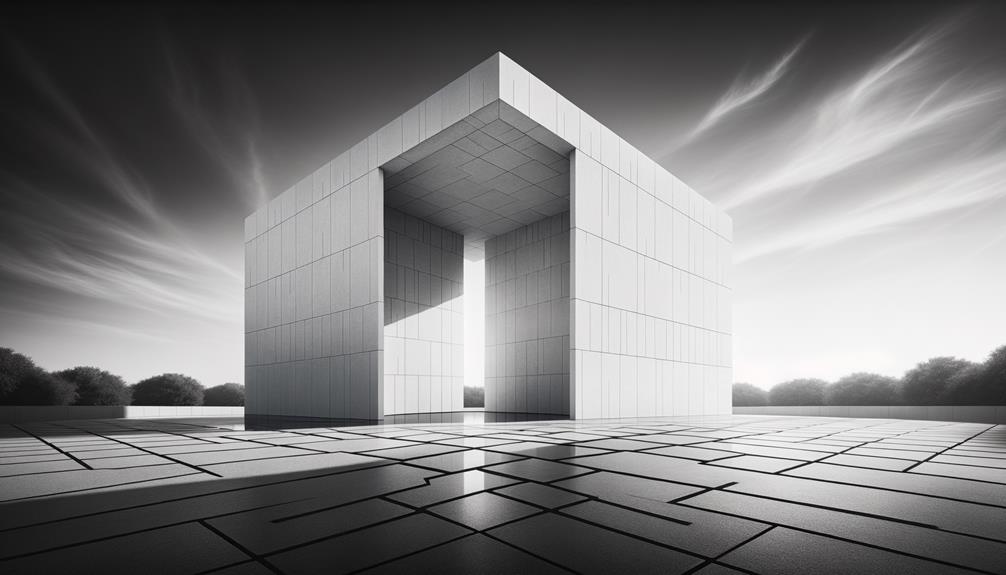
When I first saw the JFK Memorial's cenotaph, its simplicity struck me – it's a stark, white structure rising solemnly against the Dallas sky. The way the columns seem to float creates an illusion of weightlessness, as if reflecting Kennedy's enduring spirit. This design invites a quiet moment of reflection, blending seamlessly into the city's cultural landscape.
Cenotaph Design Details
The cenotaph's striking design by Philip Johnson always grabs my attention with its illusion of floating columns and serene, open space. At 30 feet high and spanning 50 by 50 feet, this architectural marvel is a testament to innovative design. Johnson's use of 72 white pre-cast concrete columns creates a sense of airiness, making the space feel both inviting and contemplative.
These columns, seemingly suspended in mid-air, symbolize the freedom of President Kennedy's spirit. It's as if the structure itself is alive, inviting onlookers to pause and reflect. Eight of these columns function as legs, supporting the entire monument and adding to its architectural significance. Their presence is subtle yet vital, grounding the design while maintaining the illusion of weightlessness.
As I walk through this space, I feel a deep sense of remembrance and reflection. The minimalist design strips away distractions, focusing attention on the intangible qualities of Kennedy's legacy. This open, airy sanctuary serves as a tribute to the power of design, blending form and function in a way that honors the past while inspiring the future. It's a place where the spirit of freedom finds a home.
Floating Columns Illusion
As I stand before the John F. Kennedy Memorial Plaza, I'm struck by the illusion of floating columns, a masterful blend of architectural genius and cultural significance. Philip Johnson's design features 72 white pre-cast concrete columns, each 30 feet high, creating an astonishing effect. At first glance, these columns appear to defy gravity, sparking both amazement and curiosity. The eight corner columns, subtly supporting the monument, amplify the illusion.
Walking through the gaps in the walls, I feel a sense of liberation and contemplation. The open spaces invite me to immerse myself in a unique and reflective environment, right in the heart of downtown Dallas. It's as if President Kennedy's spirit hovers above, serene and free, inviting visitors to reflect on his enduring legacy.
This design is more than just visually striking; it's a thoughtful representation of Kennedy's ideals. The floating columns symbolize the freedom he championed, making the John F. Kennedy Memorial Plaza a place of profound reflection and remembrance. The experience leaves a lasting impression, intertwining architectural brilliance with cultural depth.
Purpose and Interpretation

When I visit the John F. Kennedy Memorial Plaza, I'm struck by its simplicity and openness. At first, the lack of interpretive features seems intentional, inviting personal reflection and allowing each visitor to form their own connection to Kennedy's legacy. Over time, the need for more context led to the creation of The Sixth Floor Museum, which now serves as a starting point for visitors, bridging personal remembrance with historical insight.
Reflective Visitor Experience
Walking into the John F. Kennedy Memorial Plaza, I'm struck by the solemn atmosphere that invites contemplation and reflection on the life and legacy of President Kennedy. Initially, the plaza lacked interpretive features, but the public's desire for a deeper understanding led to the creation of an exhibit, which enhances the visitor experience and serves as a precursor to The Sixth Floor Museum, allowing a deeper connection with Kennedy's lasting impact.
Inside the plaza, a simple yet powerful granite marker bearing Kennedy's name stands as a poignant tribute. Designed by renowned architect Philip Johnson, the memorial's architectural design embodies a sense of openness and freedom, mirroring Kennedy's spirit. The stark, minimalist structure contrasts with the bustling city around it, creating a serene space for reflection.
As I walk through, the interpretive elements provide insight into Kennedy's vision and ideals. The experience is both reflective and educational, reminding me of the cultural and historical significance of this tribute. The John F. Kennedy Memorial Plaza stands as a timeless space for remembrance, encouraging every visitor to reflect on the values of freedom and legacy that Kennedy embodied.
Memorial Design Intentions
The John F. Kennedy Memorial Plaza's design aims to evoke a sense of freedom and introspection, inviting visitors to deeply connect with Kennedy's enduring legacy. Architect Philip Johnson's cenotaph design, a stark, open-roofed structure, embodies the unbounded spirit of President Kennedy. The simplicity and openness of the memorial encourage personal reflection, creating a space where individuals can contemplate Kennedy's vision and ideals.
Initially, the memorial lacked interpretive features, leading to the development of an exhibit to satisfy visitors' curiosity and interest. This need for a deeper connection and understanding eventually gave rise to The Sixth Floor Museum at Dealey Plaza. The memorial serves not only as a place of remembrance but also as a starting point for a broader exploration of Kennedy's life and legacy.
At the heart of the plaza lies a granite marker inscribed with Kennedy's name, adding a tangible element to the abstract design. This granite marker serves as a poignant reminder of the man whose spirit the memorial seeks to capture, blending physical presence with the ethereal nature of remembrance and freedom.
Evolution of Exhibits
As I walked away from the solemnity of the granite marker, I noticed how The Sixth Floor Museum's exhibits have evolved over time, offering a deeper understanding of Kennedy's impact and the profound sense of loss felt by the nation. Initially, the Kennedy Memorial Plaza was created for quiet reflection, with no interpretive features. However, the public's interest in JFK's legacy led to the development of an exhibit space, which eventually became The Sixth Floor Museum.
The museum's main exhibit, 'John F. Kennedy and the Memory of a Nation,' delves into the events surrounding Kennedy's assassination and its aftermath. This exhibit provides a detailed narrative that captures the enduring legacy of JFK. On the Seventh Floor, special exhibits and public programs explore various facets of Kennedy's life and presidency, sparking meaningful discussions among visitors.
For those seeking a more intimate experience, museum membership offers exclusive access to special exhibitions like 'Two Days in Texas,' which retraces President Kennedy's fateful 1963 trip. These curated experiences provide a nuanced understanding of history, highlighting the lasting impact one man can have on a nation striving for freedom and progress.
Visiting the Memorial
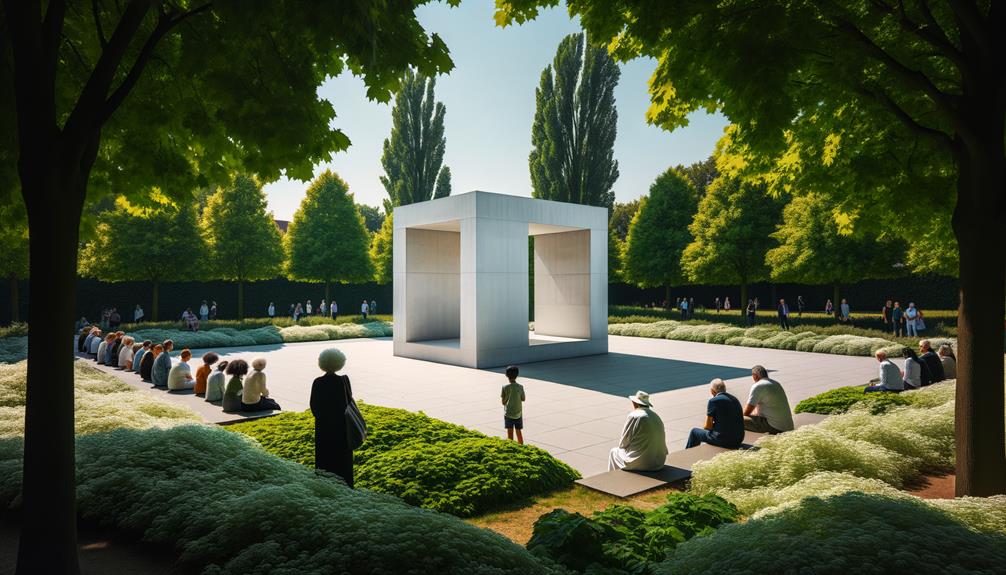
Strolling through the John F. Kennedy Memorial Plaza, I'm struck by the somber silence that surrounds the cenotaph, a tribute to a visionary leader. Located in Dallas, this memorial, designed by Philip Johnson, embodies the spirit of freedom that President Kennedy championed. The open design, featuring 72 white pre-cast concrete columns, invites contemplation and reflection.
As I walk closer, the simplicity of the structure resonates deeply, allowing visitors to focus on the profound loss and the legacy left behind. Although initially without interpretive features, the plaza now serves as a starting point for those heading to the nearby Sixth Floor Museum. This museum, situated in Dealey Plaza, explores the life, assassination, and legacy of JFK, offering a deeper understanding of the events that transpired.
The contrast between the stark cenotaph and the bustling city backdrop reminds me of the contrast in Kennedy's own life – full of hope and promise, yet tragically cut short. Visiting this memorial is a poignant reminder of the freedoms we cherish and the leaders who inspire us to protect them.
The Sixth Floor Museum

Walking from the JFK Memorial Plaza, I enter the Sixth Floor Museum, a place that promises a deeper exploration into the life and tragic end of President Kennedy. Located at 411 Elm Street in Dallas, the museum stands as a powerful tribute to a leader whose assassination still resonates deeply in American history.
As an accredited museum, the Sixth Floor Museum at Dealey Plaza offers more than just exhibits; it's an immersive experience. The main exhibits on the sixth floor meticulously detail the Kennedy assassination, featuring eyewitness accounts and recordings of Kennedy's own words. As I walk through, I feel the weight of history surrounding me.
The seventh floor features special exhibitions, such as 'Two Days in Texas,' which retraces Kennedy's fateful 1963 trip. Each display is carefully crafted, offering a poignant reflection on his assassination and legacy. By becoming a member, visitors can access these special exhibitions and enjoy exclusive benefits, deepening their connection to this pivotal moment in history.
Standing in Dealey Plaza, I'm reminded of President Kennedy's lasting impact on our pursuit of freedom and justice.
History and Management
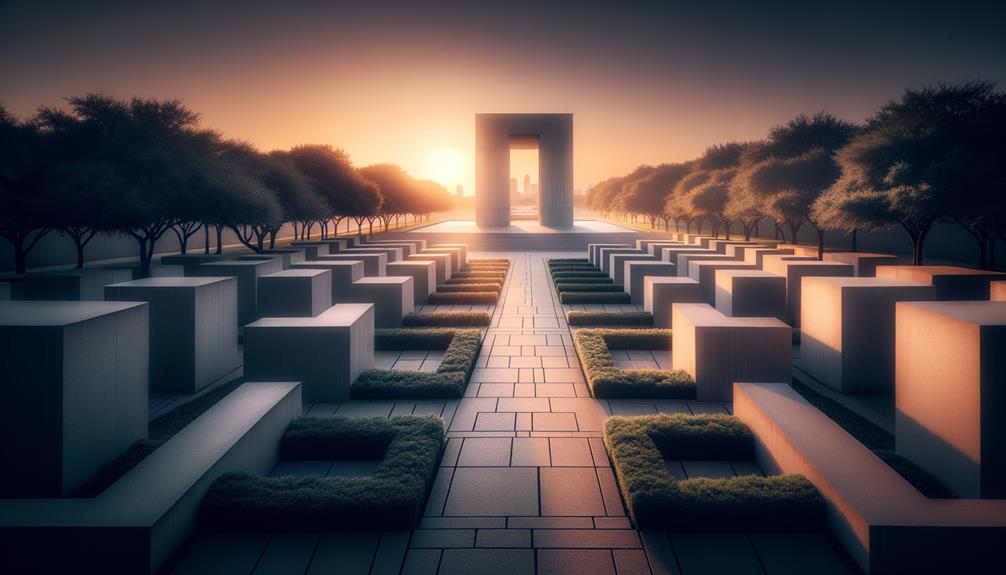
The John F. Kennedy Memorial Plaza in downtown Dallas stands as a poignant symbol of both reverence and controversy. Proposed by Dallas County Judge Lew Sterrett in 1963, the memorial was dedicated on June 24, 1970. It was designed to honor the slain president with a minimalist monument, a concept chosen from 260 proposals and funded by $200,000 from 50,000 individual donations.
Over time, the memorial faced challenges, most notably vandalism in 1999. The graffiti that marred the stark white walls prompted an urgent need for a full-scale restoration. The Sixth Floor Museum at Dealey Plaza took charge of the project, ensuring the site's dignity and historical integrity were restored. Guided by renowned architect Philip Johnson, the original designer, the restoration was meticulously carried out by Corgan Associates, Inc. and Phoenix I Restoration and Construction, Ltd.
Today, as I walk through the plaza, I reflect on its dual nature – both a solemn tribute and a site of ongoing debate. This juxtaposition encapsulates the complex legacy of both John F. Kennedy and the city of Dallas.
Critical Reception
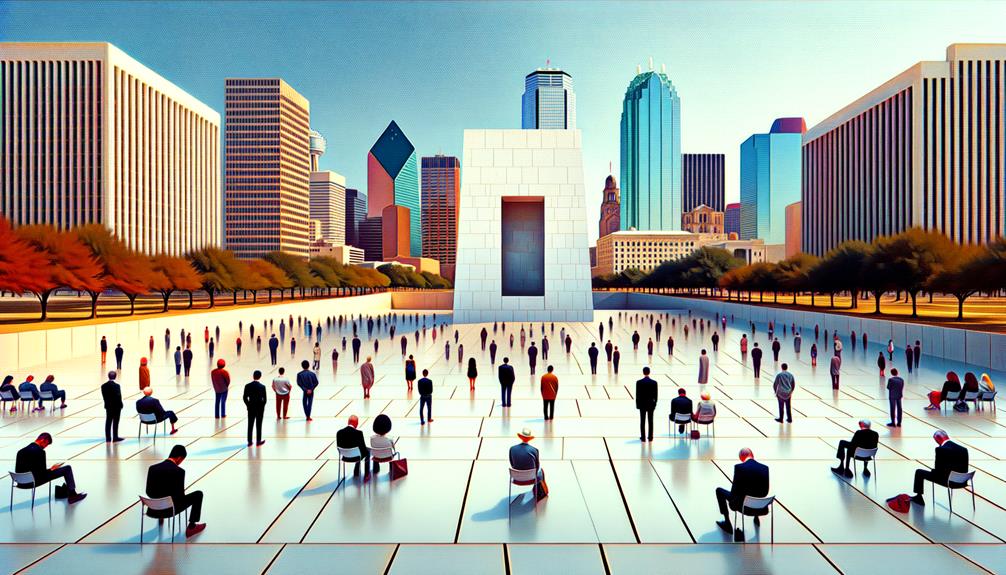
Critics have debated the JFK Memorial's design in Dallas, with its simplicity sparking a range of reactions. Some find it spare and forbidding, while others see it as disappointingly unfulfilled. Philip Johnson, the architect, intended the minimalism to create a solemn, contemplative space. However, many critics disagree.
| Critic | Year | Criticism |
|---|---|---|
| Gary Cartwright | N/A | Described the design as spare and forbidding |
| Witold Rybczynski | 2006 | Questioned its effectiveness and impact |
| Mark Lamster | 2013 | Expressed disappointment in the design |
| Christopher Hawthorne | 2013 | Criticized both design and location |
In a 1999 interview, Johnson explained that the memorial's stark design was intentional, meant to evoke reflection. However, critics like Witold Rybczynski in 2006 felt it didn't resonate with its audience.
Mark Lamster's 2013 critique echoed this sentiment, pointing to a lack of fulfillment in the memorial's execution. Similarly, Christopher Hawthorne criticized its design and location, arguing that both elements failed to honor JFK's legacy adequately.
This range of criticism highlights the challenge of creating a public monument that balances architectural vision with public expectation, especially for a figure as significant as John F. Kennedy.

